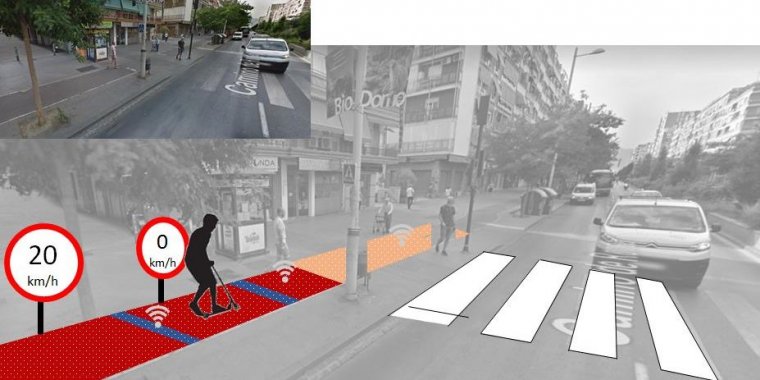| News / Science News |
Scientists design “smart” asphalts with magnetic materials for safer electric scooters
Scientists from the University of Granada have used magnetic materials in “smart” asphalts that modify their properties in the presence of external magnetic fields.

Camino de Ronda (Granada). Bicycle-friendly roads specially modified with a “smart” surface that provides a speed-reduction warning. Photo: University of Granada
This work—part of the wider research field of “smart cities”—would enable roads to signal to scooters when to slow down, for example, or could automatically cut off the electric motor or engine in case of danger.
This study, which is part of the wider “smart cities” research field, would enable roads to signal to scooters when to slow down, for example, or could automatically cut off the electric motor or engine in case of danger.
The researchers have also developed a prototype Personal Mobility Device (PMD) designed to interact with the smart asphalt.
The aim is to create better infrastructures for citizens—from public transport to energy savings, sustainability, and overall efficiency. These UGR researchers have produced more than five joint scientific publications in high-impact journals and have secured two patents—on mechano-mutable asphalt (PCT/ES2014/071002) and pavement safety systems (P201631096).
Now, with this current research, they have developed a further novel application that would address the major problem of widespread electric-scooter use in cities.
In large cities, the proliferation of PMDs, including electric scooters, demonstrates that existing infrastructures are not yet equipped to deal with such vehicles. The necessary regulation is still in its infancy (or non-existent), and the first fatal accidents associated with their use have already been reported.
Hence, research laboratories are working on innovative projects to deal with the challenges of “smart cities” or cities of the future.
One such project focuses on developing “encoded roads”, whereby different amounts of metallic material are aggregated beneath roads, pavements, and pedestrian crossings, among other areas of the city, so that a code can be generated to identify and link specific working instructions with PMDs (electric scooters) and their users.
These codes beneath the asphalt send real-time information to the PMD, indicating the necessary reduction in speed, in accordance with the zone the user is crossing at the time (or triggering motor/engine shutdown in some cases), for example.
The first PMD prototype, which interacts with these asphalt codes, was successfully presented at the 8th European Asphalt Technology Association (EATA) Conference in Granada (3–5 June 2019). (University of Granada)
YOU MAY ALSO LIKE





